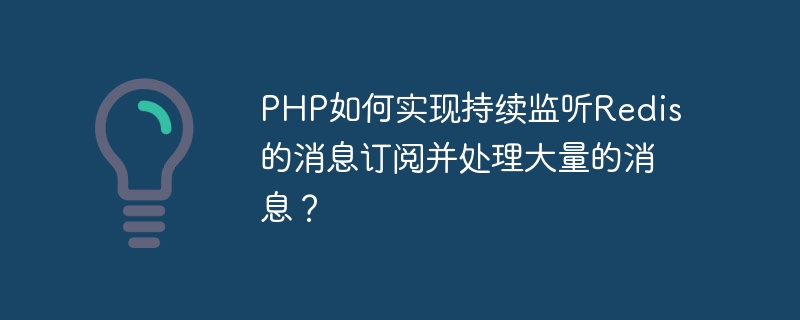

How does PHP continuously listen to Redis message subscriptions and process a large number of messages?
Overview:
Redis is a high-performance memory-based key-value database that is widely used in cache, queue, message publishing and subscription scenarios. In PHP, we can use the functions provided by the Redis extension to continuously monitor Redis message subscriptions and process a large number of messages. This article will describe how to use PHP extensions to achieve this functionality, with code examples.
1. Install the Redis extension
Before using the Redis extension, we first need to install it. You can install the Redis extension through PECL and run the following command:
pecl install redis
After successful installation, add the following line in the php.ini file:
extension=redis.so
Restart the PHP service and the Redis extension will be installed. It can be used normally.
2. Redis message subscription and processing
Redis provides two commands, subscribe and publish, for subscribing and publishing messages respectively. In PHP, we can use the subscribe command to continuously listen to Redis message subscriptions and process received messages through callback functions.
The following is an example showing how to use PHP extensions to implement Redis message subscription and processing:
<?php
$redis = new Redis();
$redis->connect('localhost', 6379);
$redis->subscribe(['channel'], function ($redis, $channel, $message) {
// 处理收到的消息
echo "Received message from channel {$channel}: {$message}
";
});In the above code, we first create a Redis instance and connect through the connect method to the Redis server. Then use the subscribe method to subscribe to the channel named 'channel' and pass in an anonymous function as the callback function. When a message is published to the channel, the callback function will be called, passing in the Redis instance, channel name and message content as parameters.
3. Concurrent processing of a large number of messages
The above code can only process one message in one process. If a large number of messages are published to Redis, the processing speed of a single process may not be able to meet the demand. In order to process a large number of messages concurrently, we can use multiple processes to create multiple consumers, each consumer is responsible for processing a part of the messages.
The following is a sample code that shows how to listen to Redis messages in multiple processes at the same time to achieve concurrent processing:
<?php
$redis = new Redis();
$redis->connect('localhost', 6379);
// 创建进程数,根据实际需求调整
$numWorkers = 4;
// 创建多个子进程
for ($i = 0; $i < $numWorkers; $i++) {
$pid = pcntl_fork();
if ($pid == -1) {
die("Could not fork");
} elseif ($pid) {
// 父进程,继续创建下一个子进程
continue;
} else {
// 子进程,执行订阅和处理逻辑
$redis->subscribe(['channel'], function ($redis, $channel, $message) {
// 处理收到的消息
echo "Received message from channel {$channel}: {$message}
";
});
break;
}
}
// 等待子进程退出
while (pcntl_waitpid(0, $status) != -1) {}In the above code, we use the pcntl_fork function to create multiple children process, and execute the logic of subscribing and processing messages in the child process. The parent process continues to create the next child process. In this way, we can create multiple consumer processes at the same time to share the load of message processing.
It should be noted that since the Redis extension uses non-blocking IO, you need to pay attention to locking when using it in a multi-process environment to prevent the occurrence of race conditions. This is not handled in the above example code. In actual applications, it needs to be handled accordingly according to the specific situation.
Summary:
This article introduces how to use PHP extensions to continuously monitor Redis message subscriptions and process a large number of messages. Through the subscribe command and callback function, we can easily monitor messages in Redis and process them according to actual needs. At the same time, by creating multiple consumers in multiple processes, we can achieve the need to process a large number of messages concurrently. I hope this article will help you understand and use Redis message subscription.
The above is the detailed content of How does PHP continuously listen to Redis message subscriptions and process a large number of messages?. For more information, please follow other related articles on the PHP Chinese website!